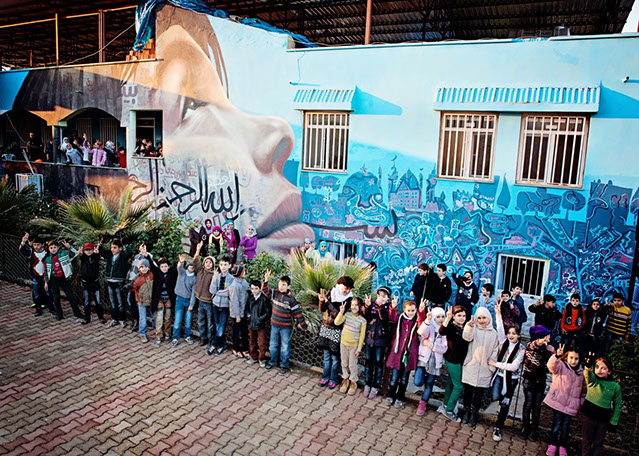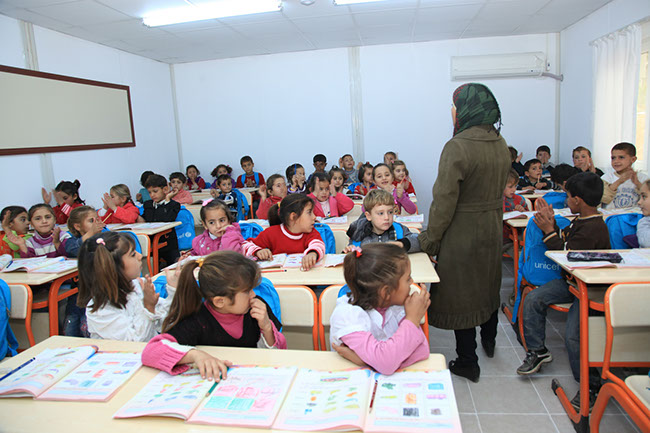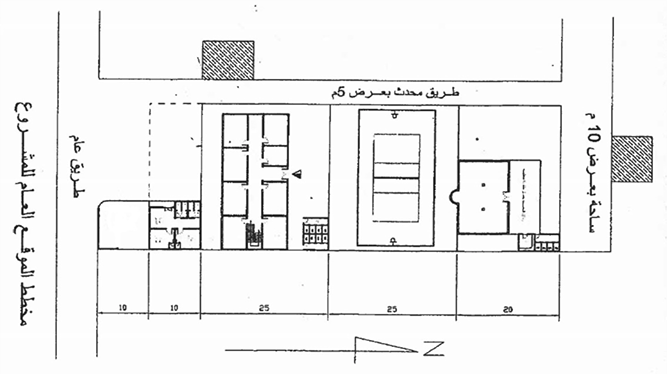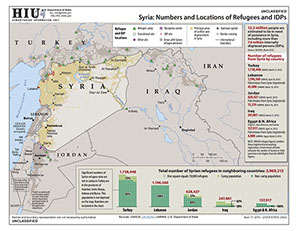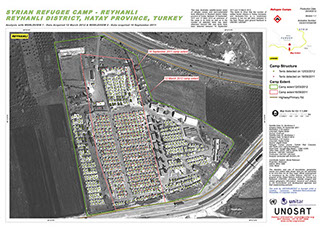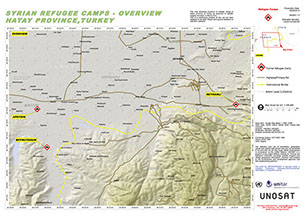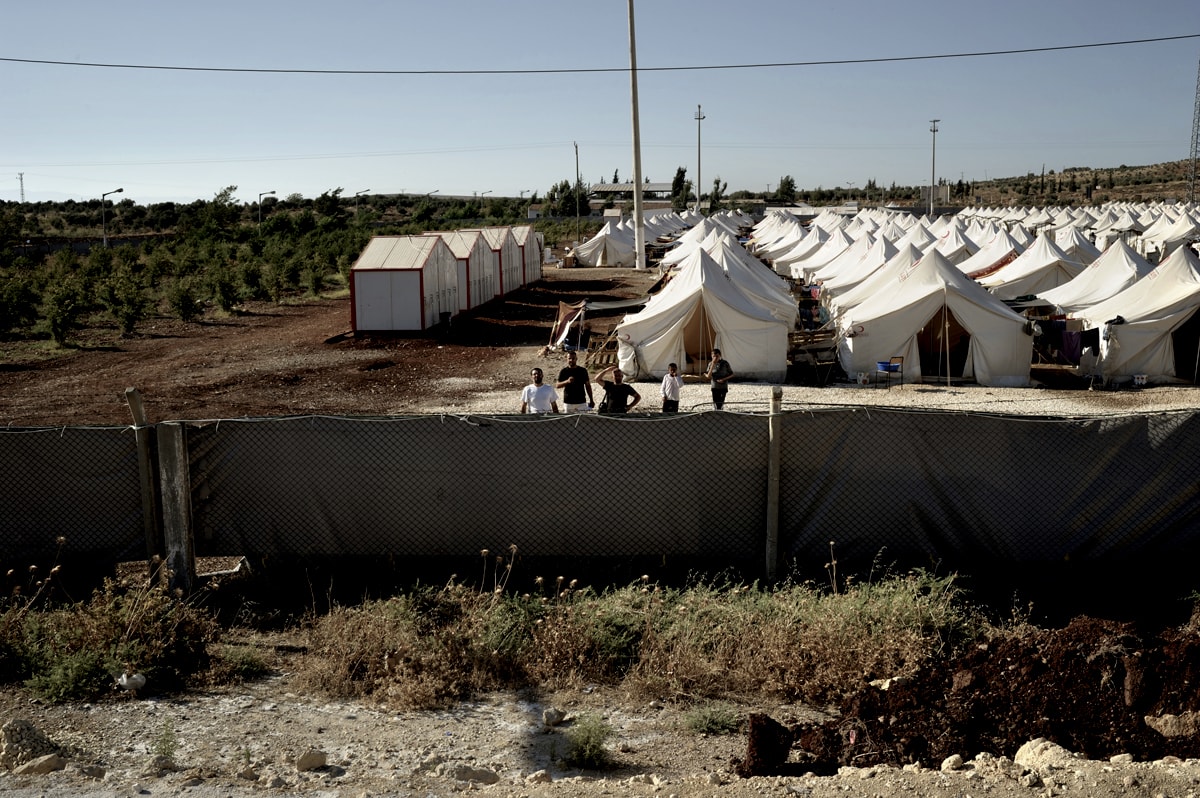
Figure 3. The Syrian Kids Foundation’s (SKF) Al-Salam school kids offers accommodates 1,860 students aged 6-17, and 90 employees, including 60 teachers.
Source: Syrian Kids Foundation/2013
The Studio
School of Architecture, McGill University
Course number: ARCH 304 Design and Construction 2
Term: Winter 2015
Instructor: Ipek Türeli
6 credits
(2-10-6) 2 hr lecture; 10 hr in-studio; additional 6 hr for assignments
This project presents fourteen proposals for Amal, a primary school for Syrian refugee children in the town of Reyhanli in Turkey. The studio created a collective and shared body of research and knowledge from which individual projects emerged.
The Syrian refugee crisis is described by the United Nations Refugee Agency (UNHCR) as the worst refugee crisis since the Second World War. However, little international humanitarian aid is going into the region. An estimated 50 percent of the refugees are children, and they are bearing the toll of this war, most now without access to basic education. This is why the studio project is called ‘Amal’, Arabic for ‘hope’, because education is the best hope for their future.
Turkey has played a crucial role in shouldering the refugee crisis. About 14 percent of recorded Syrian refugees live in the 22 camps operated by the Turkish government’s Disaster and Emergency Management Presidency (AFAD) in ten provinces—that is 220,000 of about 1.5 million refugees. The situation of those living in camps is reportedly much better than those living outside, in the communities.
Three kinds of schools currently serve Syrian refugee children in Turkey. Since the end of 2013, at the request of the government of Turkey, UNICEF has partnered with the government to focus on providing education opportunities for Syrians in Turkish host communities. They are planning on providing 40 prefabricated schools for camps.
The schools in camps, constituting the first type of schools, use an adapted Syrian curriculum and conduct lessons in Arabic. Outside the camps, Syrian refugees with residence permits can go to Turkish schools but language is a barrier.
A third kind of school in the community is operated by NGOs using, again, an adapted Syrian curriculum with Ministry of Education permission. Al-Salam School in Reyhanli is an example of this third type; it is run by a Canadian, Montreal-based NGO, Syrian Kids Foundation.
The architecture of schools founded to serve refugees do not necessarily reflect the best current practices in the design of educational facilities. Mostly improvised construction aimed at maximizing numbers, they tend to satisfy only the bare minimum. While there is indeed a shortage of educational facilities for refugees, and a need for substantially better ones, what is perhaps more challenging is maintaining their operation and thereby ensuing some continuity.
In response to these complex conditions, the students from McGill University’s School of Architecture developed approaches for the camp as well as for the community; projects that rely on prefabrication as well as local sources, labour and user participation. They designed projects that are environmentally, climatically, and culturally sensitive. A key idea was that Amal is a ‘type’ school; one that can be replicated according to need. Thus, the students speculated on how its iterations would be placed in relationship to each other in a given camp; and how they may share resources as a network of elementary schools. Individual projects analyzed and responded to precarious context and site conditions, devised an architectural program and strategy for deployment of a prototype, and applied (environmental, social, economic, and cultural) sustainable strategies pertaining to educational buildings. Finally, because of the specificity of the assigned project, the students developed an understanding of the issues surrounding the designing of, and for camps and other ‘states of exception’. This exhibition showcases the students’ propositions on how educational buildings and school architecture can respond to the ongoing humanitarian crisis.
Figure 1. The new UNICEF school will accommodate 2,200 school children. A return to learning is essential for the children of Syria to be saved from turning into a lost generation.
Source: UNICEF/Turkey2013/Feyzioglu
Download Syllabus
Figure 2. Plan of the Kafar-Rumah Civic Center built by the Aid All Syrians Foundation.
Source: Aid All Syrians/2014
Resources
Readings on Schools
Dudek, Mark. Architecture of Schools: The New Learning Environments. Oxford: Architectural Press, 2000.
Dudek, Mark. Children's Spaces. Amsterdam: Elsevier, 2005.
Syrian Refugees and the need for schools
Addario, Lynsey. "The Historic Scale of Syria’s Refugee Crisis." The New York Times. October 15, 2013. Accessed Winter
2015.
Bernard, Anne. "When a Revolt Goes Wrong." The New York Times, January 16, 2015. Accessed Winter 2015.
Evin, Mehves. "NGOs Open Special Schools for Syrians in Turkey - Al-Monitor: The Pulse of the Middle East." Al-Monitor.
January 31, 2014. Accessed Winter 2015.
Filip, Birsen. "The Dramatic Plight of Syrian Refugees in Turkey." Global Research. November 14, 2014. Accessed June 25,
2015.
Kolcu, Gamze. "Education Ministry Runs Double-shift Classes for Syrian Refugee-students." Daily News. January 3, 2015.
Accessed Winter 2015.
Kolcu, Gamze. "350,000 School-aged Syrian Children in Turkey, Just Half Receiving Education." Daily News. October 25,
2014. Accessed Winter 2015.
Ledwith, Alison. "Zaatari: The Instant City". Boston, MA: Affordable Housing Institute, 2014.
Letsch, Constanze. "Syrian Refugees Trigger Child Labour Boom in Turkey." The Guardian. September 2, 2014. Accessed
Winter 2015.
Lucas, Ryan. "More than Half of Syria's Children Affected by Civil War, UN Says." CTVNews. March 11, 2014. Accessed
Winter 2015.
Onishi, Norimitsu. "For Most Young Refugees From Syria, School Is as Distant as Home." The New York Times. December 21,
2013. Accessed Winter 2015.
Orhan, Oytun, and Sabiha Senyücel Gündoğar. Effects of the Syrian Refugees on Turkey. Report no. 195. Accessed Winter
2015.
Save the Children. Futures under Threat. Report. Save the Children Fund 2014, 2014.
Sert, Aysegul. "For Children in Turkish Refugee Camps, School's Out." The New York Times, December 28, 2014.Accessed
Winter 2015.
Suen, Fan-Yee. "Syria Refugee Crisis: Maps and Facts." CTVNews. Accessed Winter 2015.
UNHCR. 2014 Syria Regional Response Plan (RRP6), 2014.
UNHCR. "The Future of Syria | Refugee Children in Crisis." The Future of Syria. Accessed Winter 2015.
UNDP, 3RP: Regional Refugee and Resilience Plan (2015 - 2016), 2015. Accessed Winter 2015.
UNICEF. "Syrian Refugees." UNICEF – Humanitarian Action for Children -. Accessed Winter 2015.
UNICEF. Under Siege The Devastating Impact on Children of Three Years of Conflict in Syria. UNICEF. March 2014.
"Emergency Education Response to Syrian Refugees in Jordan | United Nations Educational, Scientific and Cultural
Organization." UNESCO. Accessed Winter 2015.
"How Syrian Refugee Children Are Coping." CBC. December 24, 2014.
"Montrealer En Route to Syria, Hoping to Encourage Increase in Aid." CTV Montreal News. January 17, 2014. Accessed
Winter 2015.
"Stress on Systems in Turkey." CTVNews. Accessed Winter 2015.
School Design Guidelines for North American locations
Baker, Lindsay. A History of School Design and Its Indoor Environmental Standards,1900 to Today. Washington DC:
National Clearinghouse for Educational Facilities, 2012. Print.
Larson Vaughan, Ellen, and Steven Winter. "Elementary School." Whole Building Design Guide (WBDG). National Institute of
Building Sciences, 2014. Web. Winter 2015.
U.S. Department of Energy. Energy Design Guidelines for High Performance Schools: Hot and Dry Climates. Washington, D.C.:
Office of Building Technology, State and Community Programs, Energy Efficiency and Renewable Energy, U.S. Dept. of
Energy, 2002. Print.
Architectural Design Guidelines for Schools. Alberta: Facility Planning & Architecture Section, Technical Services Branch,
November 2012.
"Great Schools by Design." American Architectural Foundation. N.p., 26 Aug. 2004. Web. Winter 2015.
Maps
Digital Globe Inc. "Firstwatch: Unrest in Syria, June 7-18, 2011." Digital Globe, 2011.
Airbus Defence and Space. "Humanitarian crisis and satellite images Camps for Syrian Refugees in Turkish Territory." Airbus
Defence and Space.
UNHCR, U.S. Department of State, UNRWA, and UN OCHA. "Syria: Numbers and Locations of Refugees and IDPs." Map.
In Humanitarian Information Unit. 2015.
UNITAR, UNOSAT. "Syrian Refugee Camps - Overview / Hatay Province, Turkey." Map. In UNITAR. 2012.
UNITAR, UNOSAT. "Syrian Refugee Camps - Reyhanli / Reyhanli District, Hatay Province, Turkey" Map. In UNITAR. 2012.
At McGill University School of Architecture
